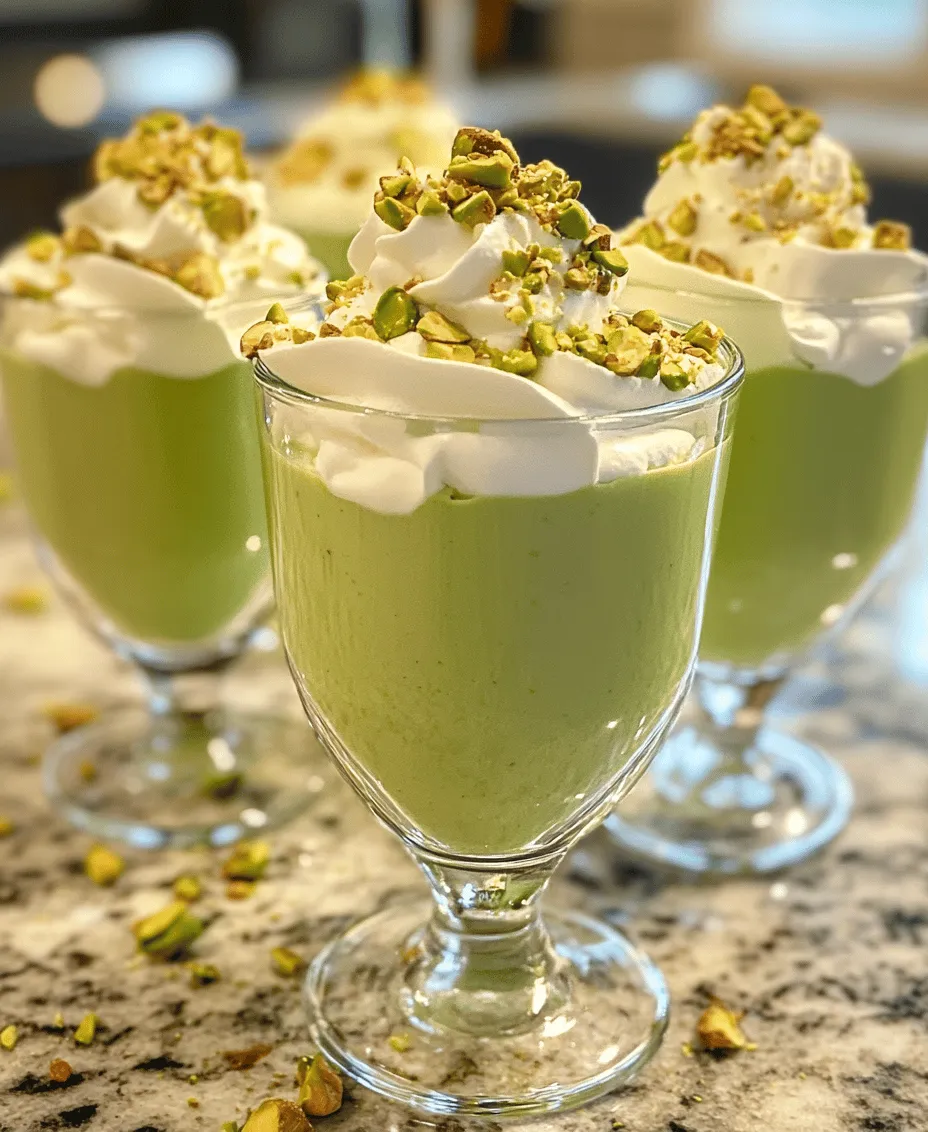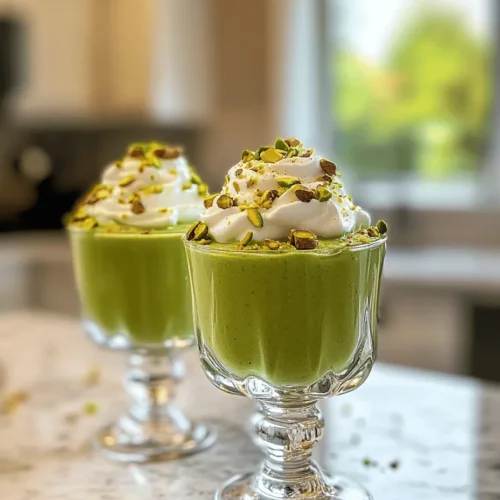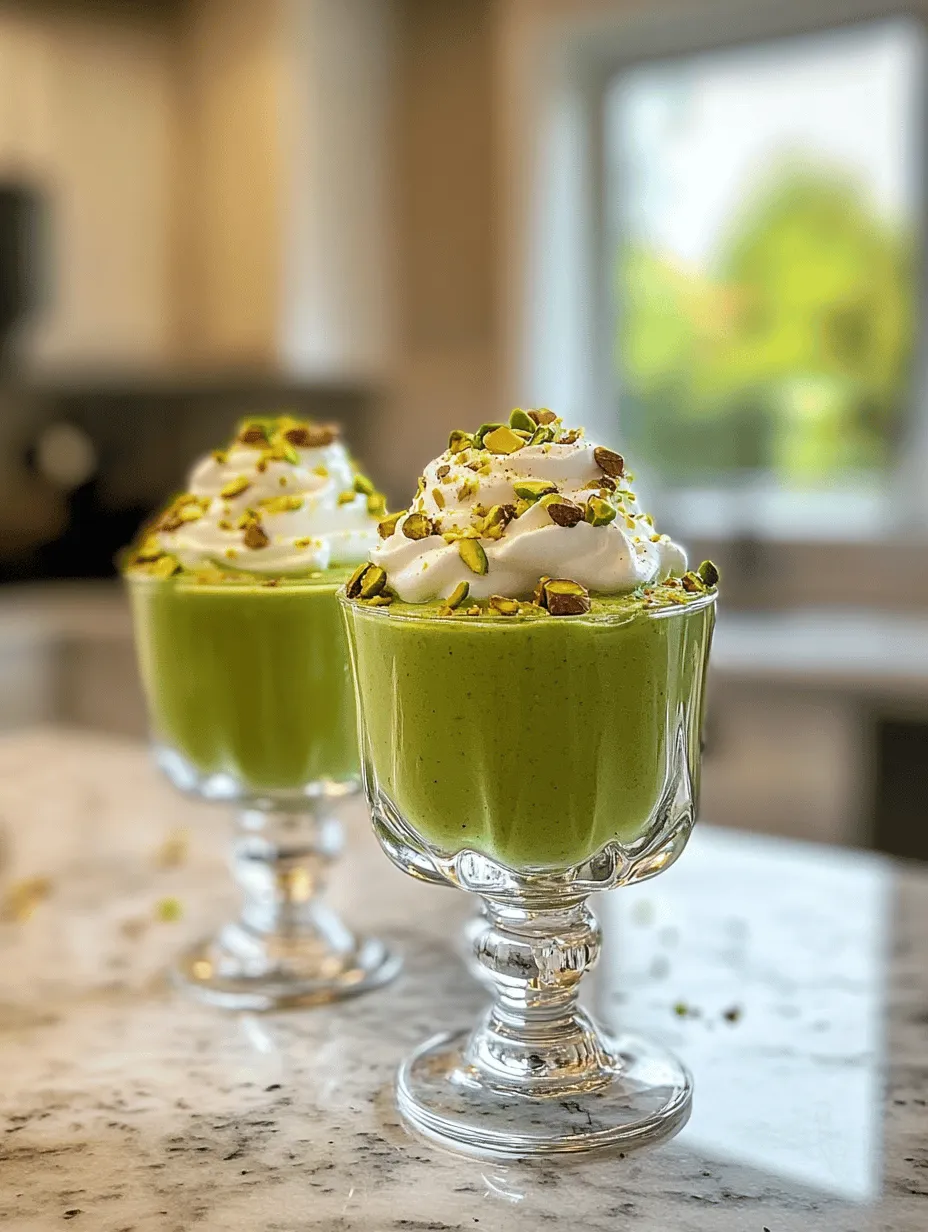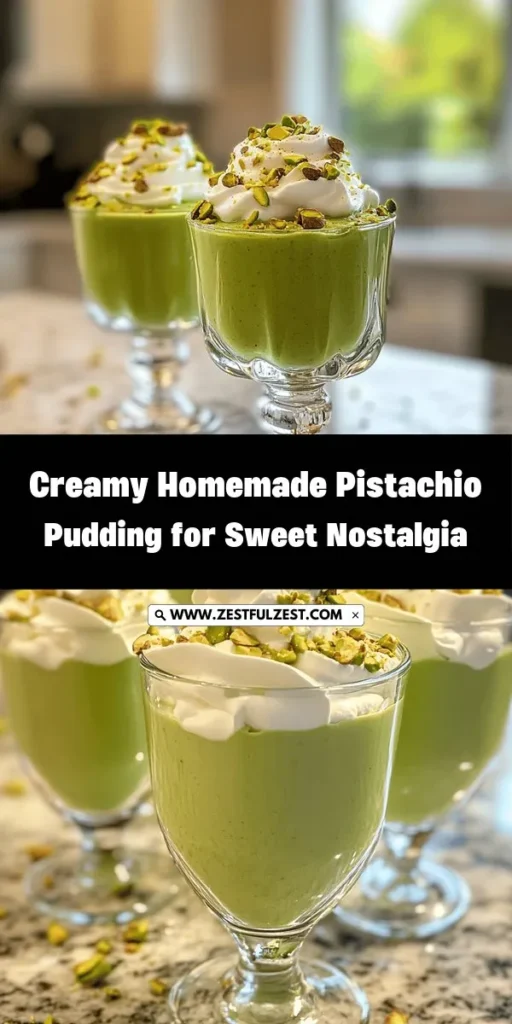Introduction
Pistachio pudding is a dessert that evokes memories of family gatherings, barbecues, and holiday celebrations. Its unique green hue and creamy texture make it a standout dish that has delighted taste buds for generations. This homemade version of pistachio pudding elevates the classic treat with its rich flavor and luxurious mouthfeel, setting it apart from the instant varieties found in stores. By using high-quality ingredients, you can achieve a velvety-smooth pudding that bursts with the distinct flavor of pistachios, creating a truly unforgettable dessert experience.
The charm of homemade pistachio pudding lies not only in its delightful taste but also in its simplicity. With just a handful of ingredients, you can create a creamy, dreamy dessert that is perfect for any occasion. Whether you’re serving it in elegant dessert cups, layering it in a parfait, or simply enjoying it straight from the bowl, this pudding is sure to impress. In this article, we will explore the nutritional benefits of pistachios, the ingredients that make this pudding exceptional, and provide step-by-step instructions to guide you through the process of making your own creamy pistachio pudding.
Understanding Pistachios
Pistachios are not only delicious but also packed with nutritional benefits. These small, green nuts are a great source of protein, fiber, and healthy fats, making them a nutritious addition to your diet. A serving of pistachios provides essential vitamins and minerals, including vitamin B6, potassium, and antioxidants. These nutrients contribute to heart health, weight management, and overall well-being, making pistachios a smart choice for health-conscious individuals.
When it comes to flavor, pistachios have a unique profile that sets them apart from other nuts. Their sweet, slightly earthy taste pairs well with both sweet and savory dishes, making them a versatile ingredient in the kitchen. In desserts, the natural nuttiness of pistachios shines through, lending an indulgent richness that is hard to resist. The culinary versatility of pistachios extends beyond pudding; they can be used in ice creams, cakes, salads, and even savory dishes like pilafs and pestos.
Culturally, pistachios hold significance in various cuisines around the world. In Middle Eastern and Mediterranean cooking, they are often used in sweets such as baklava and halva. In Italian cuisine, pistachios are a key ingredient in gelato, adding an authentic flavor that is beloved by many. The use of pistachios in these diverse culinary traditions showcases their global appeal and enduring popularity.
Ingredients Breakdown
To create the perfect homemade pistachio pudding, it’s essential to understand the role of each ingredient in the recipe. Here’s a detailed breakdown of what you will need:
1. Shelled Pistachios: The star of the show, shelled pistachios provide the foundational flavor of this pudding. When selecting pistachios, look for high-quality, unsalted varieties. You can choose between raw or roasted pistachios, with each offering a slightly different flavor profile. Roasted pistachios tend to have a deeper, nuttier flavor, while raw pistachios will impart a fresher taste.
2. Milk Options: The choice of milk can greatly influence the overall creaminess of your pudding. Whole milk is the classic option, providing a rich and creamy texture that enhances the pudding’s luxurious feel. If you’re looking for a dairy-free alternative, almond milk is a great option. It adds a subtle nutty flavor that complements the pistachios beautifully, though it may result in a slightly thinner consistency compared to whole milk.
3. Sugar Alternatives: While granulated sugar is the typical sweetener used in pudding recipes, there are several natural sweeteners you can explore. Honey, maple syrup, or agave nectar can be used as alternatives, each imparting a unique flavor to the pudding. Keep in mind that these sweeteners may alter the overall sweetness and texture, so adjustments may be needed.
4. Cornstarch: This ingredient serves as a thickening agent for your pudding, providing that desirable creamy consistency. Cornstarch works by absorbing moisture and swelling when heated, which helps to create a stable pudding that holds its shape. For those with dietary restrictions, there are cornstarch alternatives like arrowroot powder that can be used in a similar capacity.
5. Salt: A pinch of salt may seem insignificant, but it plays a crucial role in enhancing the flavors of sweet dishes. Salt balances the sweetness of the pudding and brings out the natural nuttiness of the pistachios, resulting in a more complex and satisfying flavor.
6. Vanilla Extract: Vanilla extract adds depth to the pudding, complementing the pistachio flavor beautifully. There are various types of vanilla extract available, including pure vanilla extract and imitation vanilla. For the best flavor, opt for pure vanilla extract, as it is made from real vanilla beans and contributes a more authentic taste.
7. Butter vs. Coconut Oil: The final ingredient in this pudding is fat, which contributes to the overall creaminess and mouthfeel. Traditional recipes often call for butter, which adds a rich flavor. However, for a dairy-free option, coconut oil can be used. Coconut oil lends a subtle coconut flavor and is a great alternative for those following a vegan or lactose-free diet.
Step-by-Step Instructions
Now that we’ve covered the ingredients, let’s dive into the preparation of your creamy dreamy homemade pistachio pudding.
1. Preparing the Pistachios: Start by measuring out your shelled pistachios. If you’re using raw pistachios, consider roasting them slightly in a dry skillet over medium heat for 5-7 minutes. This will enhance their flavor and aroma. Allow them to cool before proceeding. Once cooled, blend the pistachios in a food processor until finely ground, resembling a coarse meal. This step is crucial as it will determine the texture of your pudding – too chunky, and the pudding may be grainy; too finely ground, and you may lose the pistachio flavor.
2. Importance of Texture in the Pudding: The texture of your pudding is key to achieving that creamy, dreamy consistency that makes it so delightful. As you process the pistachios, keep an eye on their texture. You want a fine grind that still retains some small pieces for added texture. If you prefer a smoother pudding, you can strain the blended mixture through a fine-mesh sieve to remove any larger bits, though this is entirely optional.
3. Combining and Cooking the Mixture: In a medium saucepan, combine the ground pistachios, sugar, cornstarch, and salt. Whisk these dry ingredients together to ensure they are evenly distributed. Gradually stir in your choice of milk, making sure to incorporate it smoothly without any lumps. Place the saucepan over medium heat and continue to whisk the mixture as it heats up.
As the mixture begins to warm, it will start to thicken. Continue to whisk constantly to prevent any sticking or burning on the bottom of the pan. Once the pudding reaches your desired thickness, remove it from the heat and stir in the vanilla extract and butter (or coconut oil). Mix until everything is well combined and the butter has melted completely, creating a luxuriously smooth pudding.
By following these initial steps carefully, you are well on your way to creating a delightful homemade pistachio pudding that will impress your family and friends. Stay tuned for the next part, where we will explore additional tips for achieving the best results and address common questions about this delicious dessert.

Techniques for Avoiding Lumps When Mixing Dry and Wet Ingredients
Creating a smooth and creamy pistachio pudding starts with proper technique, particularly when combining your dry and wet ingredients. To prevent lumps, it’s essential to mix your dry ingredients thoroughly before introducing any liquid. Begin by sifting your cornstarch and sugar together in a bowl. This step not only breaks up any clumps but also ensures that the cornstarch is evenly distributed.
When you’re ready to combine the dry ingredients with the wet ingredients, pour the liquid in slowly while whisking continuously. This technique allows the cornstarch to hydrate gradually, preventing any lumps from forming. Additionally, consider using a whisk instead of a spoon; the whisk’s shape and motion can help blend the ingredients more effectively. If you do encounter lumps, don’t despair. Simply use an immersion blender to smooth out the mixture before cooking.
Key Indicators for Knowing When the Pudding is Cooked
Cooking the pudding to the right consistency is essential for achieving that creamy texture. As you heat your mixture, keep an eye on its appearance and behavior. The first key indicator that your pudding is nearly done is when it begins to thicken. You will notice it transitioning from a liquid to a more viscous state. This usually takes about 5-10 minutes over medium heat.
The second indicator is bubbling. Once you see small bubbles forming at the surface, it’s a sign that the pudding has reached a temperature high enough for the cornstarch to activate and thicken the mixture. At this point, continue stirring for another minute or two to ensure the pudding is fully cooked. It’s crucial not to rush this process, as undercooked pudding can result in a runny texture.
Infusing Flavors
Pistachio pudding is delicious on its own, but you can enhance its flavor profile by infusing it with additional ingredients. As pistachios release their oils and essence when heated, consider adding a splash of vanilla extract or almond extract to complement their nutty flavor. Both extracts can elevate the overall taste and add depth to your pudding.
Another interesting approach is to steep the milk or cream with spices like cardamom or cinnamon before mixing it into the pudding. Heat the milk gently with the spices, allowing the flavors to meld before straining them out. This infusion method not only adds complexity to the flavor but also creates a more aromatic experience.
The Impact of Heat on Flavor Release from Pistachios
The cooking process significantly affects the flavor of your pistachios. When heated, the natural oils present in the nuts are released, enhancing their nuttiness and overall taste. This is why toasting the pistachios before adding them to the pudding can elevate the flavor even further. Simply spread the nuts on a baking sheet and toast them in the oven at 350°F (175°C) for about 8-10 minutes, or until they’re fragrant and lightly golden.
By incorporating toasted pistachios into your pudding, you not only boost the flavor but also add a delightful crunch that contrasts beautifully with the creamy texture. This extra step is certainly worth the time for a more robust pistachio pudding experience.
Cooling and Serving
Once your pudding has thickened to perfection, it’s time to cool it down. Proper cooling is vital to achieving the right texture. Transfer the pudding to a bowl and cover it with plastic wrap, pressing the wrap directly onto the surface of the pudding to prevent a skin from forming. Allow it to cool at room temperature for about 30 minutes before transferring it to the refrigerator to chill for at least 2 hours.
For a visually appealing dessert, consider how you present your pistachio pudding. Serve it in individual cups or bowls, and for added elegance, garnish with whipped cream, crushed pistachios, or a sprinkle of edible flowers. Layering the pudding with other complementary ingredients, such as fruit or chocolate, can create an enticing parfait that showcases your culinary creativity.
The Science of Pudding
Understanding the science behind pudding can help you appreciate the delicate balance of ingredients that results in the perfect texture. At the core of pudding thickening is cornstarch, which is a polysaccharide that thickens when heated with a liquid. When cornstarch is mixed with liquid and heated, the granules swell and absorb water, creating a gel-like consistency.
Temperature plays a critical role in this process. Heating the mixture causes the starch molecules to break down and expand, thickening the pudding as it cooks. However, if the temperature is too high or if the pudding is cooked for too long, it can break down and become watery. Therefore, it’s essential to monitor the heat carefully as you cook your pudding, ensuring it thickens without overcooking.
Variations and Customizations
One of the joys of making homemade pistachio pudding is the ability to customize the flavors to your liking. For a chocolate pistachio pudding, simply add cocoa powder to the dry ingredients, adjusting the sugar to balance the flavors. If you enjoy spices, a hint of cardamom or nutmeg can add warmth and complexity.
For those on a vegan or gluten-free diet, adaptations are simple. Substitute regular milk with almond milk or coconut milk, ensuring it’s unsweetened to maintain the pudding’s flavor balance. For a gluten-free option, cornstarch can be used instead of wheat flour for thickening, making this pudding accessible to everyone.
Creative serving ideas abound as well. Consider layering the pudding in a glass with granola, fresh berries, or a drizzle of honey for a visually stunning dessert that dazzles the palate. These layered desserts not only look great but are also fun to eat.
Serving Suggestions and Pairings
Pistachio pudding is versatile and can be served on various occasions, from family dinners to elegant gatherings. It’s an excellent choice for holidays, summer picnics, or simply as a delightful treat after dinner. Pair it with light desserts like lemon bars or fruit tarts to balance the creaminess with refreshing flavors.
When it comes to beverages, consider serving your pudding alongside a cup of herbal tea or a light dessert wine. The nutty flavor of the pistachios pairs beautifully with floral teas or sweet dessert wines, enhancing the overall dining experience.
Conclusion
Making and enjoying homemade pistachio pudding is a rewarding culinary experience that brings joy to both the cook and the eater. The satisfaction of using fresh, high-quality ingredients allows you to create a dessert that is not only delicious but also personal. Whether you choose to stick to the classic recipe or experiment with flavors and presentations, this pudding is sure to impress.
As you embark on your pistachio pudding journey, remember that the beauty of homemade desserts lies in their versatility. Don’t hesitate to try new flavors, textures, and serving styles. Share your creations with friends and family, and enjoy the delightful smiles that follow. Happy cooking!



